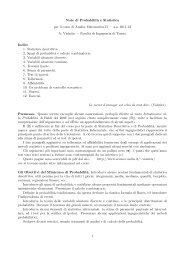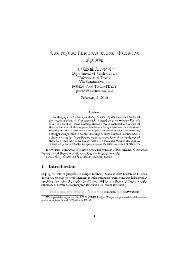Hydrogen Sulfide (H2S) - OSHA
Hydrogen Sulfide (H2S) - OSHA
Hydrogen Sulfide (H2S) - OSHA
Create successful ePaper yourself
Turn your PDF publications into a flip-book with our unique Google optimized e-Paper software.
FactSheet<br />
<strong>Hydrogen</strong> <strong>Sulfide</strong> (<strong>H2S</strong>)<br />
<strong>Hydrogen</strong> sulfide is a colorless, flammable, extremely hazardous gas with a “rotten<br />
egg” smell. Some common names for the gas include sewer gas, stink damp,<br />
swamp gas and manure gas. It occurs naturally in crude petroleum, natural gas,<br />
and hot springs. In addition, hydrogen sulfide is produced by bacterial breakdown<br />
of organic materials and human and animal wastes (e.g., sewage).<br />
Industrial activities that can produce the gas include petroleum/natural gas<br />
drilling and refining, wastewater treatment, coke ovens, tanneries, and kraft<br />
paper mills. <strong>Hydrogen</strong> sulfide can also exist as a liquid compressed gas.<br />
Hazardous properties of H 2 S gas<br />
<strong>Hydrogen</strong> sulfide is heavier than air and may<br />
travel along the ground. It collects in low-lying<br />
and enclosed, poorly-ventilated areas such as<br />
basements, manholes, sewer lines, underground<br />
telephone vaults and manure pits.<br />
For work within confined spaces, use appropriate<br />
procedures for identifying hazards,<br />
monitoring and entering confined spaces.<br />
The primary route of exposure is inhalation<br />
and the gas is rapidly absorbed by the lungs.<br />
Absorption through the skin is minimal.<br />
People can smell the “rotten egg” odor of<br />
hydrogen sulfide at low concentrations in air.<br />
However, with continuous low-level exposure,<br />
or at high concentrations, a person<br />
loses his/her ability to smell the gas even<br />
though it is still present (olfactory fatigue).<br />
This can happen very rapidly and at high<br />
concentrations, the ability to smell the gas<br />
can be lost instantaneously. Therefore, DO<br />
NOT rely on your sense of smell to indicate<br />
the continuing presence of hydrogen sulfide<br />
or to warn of hazardous concentrations.<br />
In addition, hydrogen sulfide is a highly flammable<br />
gas and gas/air mixtures can be explosive.<br />
It may travel to sources of ignition and<br />
flash back. If ignited, the gas burns to produce<br />
toxic vapors and gases, such as sulfur<br />
dioxide.<br />
Contact with liquid hydrogen sulfide causes<br />
frostbite. If clothing becomes wet with the<br />
liquid, avoid ignition sources, remove the<br />
clothing and isolate it in a safe area to allow<br />
the liquid to evaporate.<br />
Health effects of H 2 S exposure<br />
<strong>Hydrogen</strong> sulfide is both an irritant and a<br />
chemical asphyxiant with effects on both<br />
oxygen utilization and the central nervous<br />
system. Its health effects can vary depending<br />
on the level and duration of exposure.<br />
Repeated exposure can result in health effects<br />
occurring at levels that were previously tolerated<br />
without any effect.<br />
Low concentrations irritate the eyes, nose,<br />
throat and respiratory system (e.g., burning/<br />
tearing of eyes, cough, shortness of breath).<br />
Asthmatics may experience breathing difficulties.<br />
The effects can be delayed for several<br />
hours, or sometimes several days, when<br />
working in low-level concentrations. Repeated<br />
or prolonged exposures may cause eye<br />
inflammation, headache, fatigue, irritability,<br />
insomnia, digestive disturbances and weight<br />
loss.<br />
Moderate concentrations can cause more<br />
severe eye and respiratory irritation (including<br />
coughing, difficulty breathing, accumulation<br />
of fluid in the lungs), headache, dizziness,<br />
nausea, vomiting, staggering and excitability.
High concentrations can cause shock, convulsions,<br />
inability to breathe, extremely rapid<br />
unconsciousness, coma and death. Effects<br />
can occur within a few breaths, and possibly<br />
a single breath.<br />
Protection against H 2 S exposure<br />
Before entering areas where hydrogen sulfide<br />
may be present:<br />
1. Air must be tested for the presence and<br />
concentration of hydrogen sulfide by a<br />
qualified person using air monitoring<br />
equipment, such as hydrogen sulfide<br />
detector tubes or a multi-gas meter that<br />
detects the gas.<br />
Testing should also determine if fire/<br />
explosion precautions are necessary.<br />
2. If the gas is present, the space/area must<br />
be ventilated continually to remove the<br />
gas.<br />
3. If the gas cannot be removed, the person<br />
entering the space/area must use appropriate<br />
respiratory protection and any<br />
other necessary personal protective<br />
equipment, rescue and communication<br />
equipment.<br />
<strong>OSHA</strong>’s Confined Spaces standard contains<br />
specific requirements for identifying,<br />
monitoring and entering confined spaces.<br />
Entering dangerous H 2 S atmospheres<br />
A level of H 2 S gas at or above 100 ppm is<br />
Immediately Dangerous to Life and Health<br />
(IDLH). Entry into IDLH atmospheres can only<br />
be made using: 1) a full facepiece pressure<br />
demand self-contained breathing apparatus<br />
(SCBA) with a minimum service life of thirty<br />
minutes, or 2) a combination full facepiece<br />
pressure demand supplied-air respirator with<br />
an auxiliary self-contained air supply.<br />
If H 2 S levels are below 100 ppm, an air-purifying<br />
respirator may be used, assuming the<br />
filter cartridge/canister is appropriate for<br />
hydrogen sulfide. A full facepiece respirator<br />
will prevent eye irritation.<br />
If air concentrations are elevated, eye irritation<br />
may become a serious issue. If a halfmask<br />
respirator is used, tight fitting goggles<br />
must also be used.<br />
Workers in areas containing hydrogen sulfide<br />
must be monitored for signs of overexposure.<br />
NEVER attempt a rescue in an area that may<br />
contain hydrogen sulfide without using<br />
appropriate respiratory protection and without<br />
being trained to perform such a rescue.<br />
This is one in a series of informational fact sheets highlighting <strong>OSHA</strong> programs, policies or<br />
standards. It does not impose any new compliance requirements. For a comprehensive list of<br />
compliance requirements of <strong>OSHA</strong> standards or regulations, refer to Title 29 of the Code of Federal<br />
Regulations. This information will be made available to sensory impaired individuals upon request.<br />
The voice phone is (202) 693-1999; teletypewriter (TTY) number: (877) 889-5627.<br />
For more complete information:<br />
U.S. Department of Labor<br />
www.osha.gov<br />
(800) 321-<strong>OSHA</strong><br />
DSG 10/2005

















